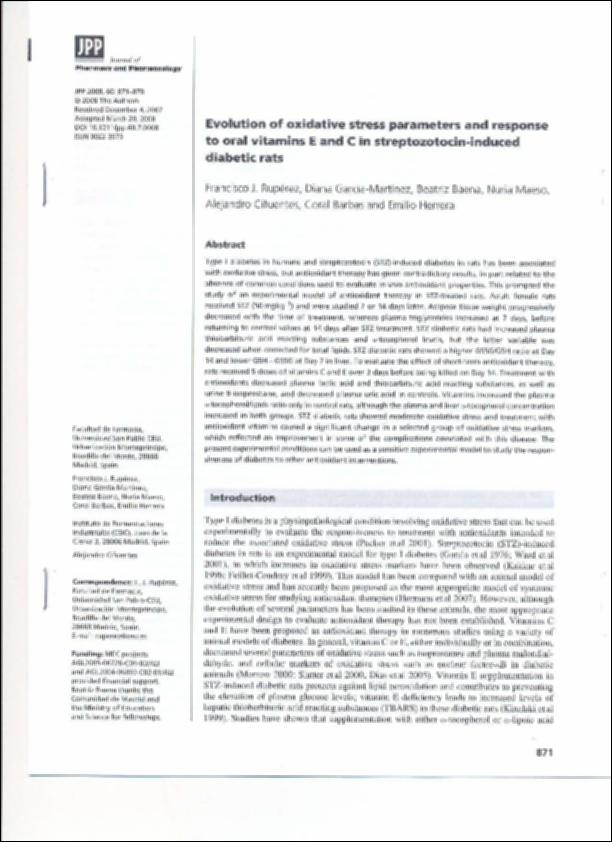Por favor, use este identificador para citar o enlazar este ítem:
http://hdl.handle.net/10637/2868Evolution of oxidative stress parameters and response to oral vitamin E and C administration in streptozotocin diabetic rats.
| Título : | Evolution of oxidative stress parameters and response to oral vitamin E and C administration in streptozotocin diabetic rats. |
| Autor : | Rupérez Pascualena, Francisco Javier García Martínez, Diana Baena, Beatriz Maeso Nava, Nuria Cifuentes, Alejandro Barbas Arribas, Coral. Herrera Castillón, Emilio. |
| Resumen : | Type I diabetes in humans and streptozotocin (STZ)-induced diabetes in rats has been associated with oxidative stress, but antioxidant therapy has given contradictory results, in part related to the absence of common conditions used to evaluate in-vivo ant ioxidant properties. This prompted the study of an experimental model of antioxidant therapy in STZ-treated rats. Adult female rats received STZ (SOmgkg1 ) and were studied 7 or 14 days later. Adipose tissue weight progressively decreased with the time of treatment, whereas plasma triglycerides increased at 7 days, before returning to control values at 14 days after STZ treatment. STZ diabetic rats had increased plasma thiobarbituric acid reacting substances and o-tocopherol levels, but the latter variable was decreased when corrected for total lipids. STZ diabetic rats showed a higher GSSG/GSH ratio at Day 14 and lower GSH + GSSG at Day 7 in liver. To evaluate the effect of short-term antioxidant therapy, rats received 5 doses of vitamins C and E over 3 days before being killed on Day 14. Treatment with antioxidants decreased plasma lactic acid and thiobarbituric acid reacting substances, as well as urine 8-isoprostane. and decreased plasma uric acid in controls. Vitamins increased the plasma o:-tocopherol/lipids ratio only in control rats, although the plasma and liver o-tocopherol concentration increased in both groups. STZ diabetic rats showed moderate oxidative stress and treatment with antioxidant vitamins caused a significant change in a selected group of oxidative stress markers, which reflected an improvement in some of the complications associated with this disease. The present experimental conditions can be used as a sensitive experimental model to study the responsiveness of diabetes to other antioxidant interventions. |
| Descripción : | En: Journal of pharacy and pharmacology 2008. n. 60 : 871-878 p. ISSN. 0022-3573 |
| URI : | http://hdl.handle.net/10637/2868 |
| Derechos: | http://creativecommons.org/licenses/by-nc-nd/4.0/deed.es |
| Fecha de publicación : | 19-sep-2008 |
| Centro : | Universidad San Pablo-CEU |
| Aparece en las colecciones: | Facultad de Farmacia |
Los ítems de DSpace están protegidos por copyright, con todos los derechos reservados, a menos que se indique lo contrario.


